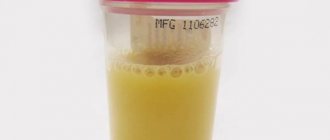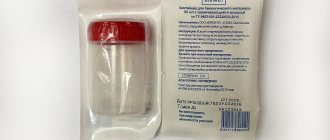We tell you what you can find out about your health by receiving a form with the results of the study.
It is better to decipher a general urine test together with a doctor. The fact is that the indicators of this analysis for different diseases can be quite similar. To make an accurate diagnosis, you need to take into account the patient’s complaints and pay attention to the external signs of a specific disease. Without a doctor, this task is impossible.
“It is necessary to evaluate different urine indicators in a complex manner. It rarely happens that only one indicator is changed; usually several change at once, - urologist of the 1st Danilovsky Multidisciplinary Medical Center Rinaz Kamaletdinov. “And in order to understand what exactly is happening to the patient, it is necessary to take into account the patient’s complaints, his symptoms and apply additional diagnostic methods. After all, we are not treating the analysis, but the patient.”
In addition, there are situations when test results deviate from the norm not because of illness, but because of physical activity, changes in the menu, or taking certain medications. For example, after several hours in the gym, the number of leukocytes in the blood may increase, beets eaten the day before can turn urine pink, and the anti-inflammatory drug indomethacin can turn it blue-green. Therefore, having received a “non-standard” urine test, you need to discuss its results with your doctor: to make sure that a problem exists, the doctor will prescribe a repeat urine test, or refer you for some other test.
However, you can understand some things on your own. The main thing is not to draw far-reaching conclusions from this and not to run to the pharmacy without first talking with a specialist. In forms from different laboratories, the results of a urine test may be presented slightly differently, but almost everywhere they will be grouped by the appearance of the urine, its chemical properties and the results of examination under a microscope.
Appearance
Color. Normal urine color is yellow: from straw yellow to dark amber. The shade depends on the concentration of urochrome, a coloring pigment in urine. Concentrated urine that has been sitting in the bladder overnight has more urochrome, so the urine will be more amber. And if a person has recently drunk water, the color will be more like straw.
In this case, urine can be colored in almost all the colors of the rainbow. Moreover, an unusual shade can either be a variant of the norm or indicate a disease. Moreover, urinary tract infections can produce different shades of urine - the color depends on the specific type of pathogenic microorganisms.
“Sometimes a patient’s urine turns red,” says Svetlana Artemova, candidate of medical sciences, nutritionist and nephrologist at GMS Clinic. Without analysis it is impossible to understand why this happens. This may be due, for example, to eating beets, to treatment with sulfonamides, or to rhabdomyolysis, a condition in which muscle tissue is destroyed.”
Fourth look. American-practical
There were always problems with urine. More precisely, without urine. In recent years, laboratories have experienced an acute shortage of urine, no matter how paradoxical it may sound. Even hard-earned liters of precious liquid are very difficult to preserve. It should be stored refrigerated, and for transportation over long distances, urine must be frozen.
Besides, urine donors... the girl in the front row, I didn't say anything funny, these are the same donors as those who donate blood, sperm or eggs. So, very strict requirements are imposed on urine donors: they should not have any chronic diseases, they should not use drugs, and they should have led a healthy lifestyle for quite a long time before donating urine.
Another trouble: urine, being a biological fluid, has a very specific odor. During long-term storage, decomposing organic substances, which are always present in urine, do not deodorize it.
And finally, two absolutely identical urine samples simply cannot exist in nature, just as there are no absolutely identical people - even twins can be distinguished from each other. Even in the same person, urine characteristics change throughout the day.
It cannot be said that the idea of creating a synthetic analogue of urine is revolutionary; attempts to create a urine substitute have been made repeatedly. Only they all boiled down to liquids based on the same human urine with the addition of various kinds of preservatives and stabilizers.
But, according to the president of the American research corporation Duo Research, Robert Willett, all these samples did not withstand “field tests” and, quite logically, did not have commercial success.
Meanwhile, another American, an employee of the investment company Kevin Dyches, decided to acquire a small company - Dyna-Tek, which was engaged in the production and sale of various sized laboratory glassware. An unfinished development was gathering dust in the company's archives - a technology for the production of artificial urine, which in composition is no different from normal human urine, but is devoid of its unpleasant qualities.
The already mentioned Robert Willett, as well as several other specialists, advised Diches to complete the research and launch synthetic urine into production, predicting a resounding commercial success for it. After calculating all the options and researching this market segment, Diches came to the conclusion that the game was worth the candle.
He wasn't wrong. All research laboratories unanimously declared that Diches' urine, or more precisely, the Dyna-Tek product, simply called Surine (short for synthetic urine), is the most natural urine. Any beer manufacturer would have been shocked by such an expert conclusion, but Diches was very pleased with this conclusion.
The government's Centers for Disease Control and Prevention (CDC) became its first client. This institution purchased 33 liters of artificial urine for testing. The head of one of the CDC divisions, David Ashley, praised the quality of Surine and expressed a desire to constantly purchase Dyna-Tek urine, and in significant quantities.
The turnover of Diches's company is still very modest - about 500 thousand dollars a year, and income from sales of Surine is only 7 percent of this amount. However, Kevin is optimistic in his forecasts. “I’ll be disappointed if it doesn’t reach 90 percent in five years,” Diches said.
Reasons why urine may change color
| Color | Natural causes | Diseases |
| Red | Food: beets, blackberries, rhubarb stain the urine. Medicines: for example, chlorpromazine or propofol. | Urinary tract infection Rhabdomyolysis (a condition in which muscle tissue breaks down) Trauma to the urinary tract (eg associated with passing kidney stones) Porphyria (hereditary disorder of pigment metabolism) |
| Orange | Diet: carrots stain urine, vitamin C supplements Medications: e.g. rifampicin or phenazopyridine | — |
| Green | Diet: Asparagus and B vitamin supplements stain urine. Medications: such as propofol or amitriptyline. | Urinary tract infection |
| Blue | Medicines: for example, indomethacin or amitriptyline | Blue diaper syndrome in infants (a disease associated with malabsorption of the amino acid tryptophan) |
| Violet | — | Purple pouch syndrome (urinary tract infection and patients with urinary catheter) |
| Black | Diet: Some types of beans stain the urine. Medications: such as levodopa or metronidazole. | Gilbert's syndrome (hereditary liver disease) Biliary tract diseases |
| White | Medicines: for example, propofol | Hiluria (a disease in which the lymphatic vessels of the kidneys dilate, and lymph, the liquid part of the blood, appears in the urine) Inflammatory diseases of the urinary tract, in which pus appears in the urine (that is, a large number of white blood cells) Urolithiasis, in which phosphate crystals appear in the urine |
Transparency. Normally, urine should be clear. The cause of the turbidity is determined through chemical and microscopic analysis. As a rule, this is not the norm: it could be, for example, bacteria, salts, mucus or a large number of leukocytes.
Specific gravity. This indicator reflects the concentration of substances dissolved in urine. In healthy people during the day it fluctuates 1.008−1.025 g/l. If the specific gravity decreases, this may indicate that the person simply drank a lot of water, and that there are problems with the concentrating ability of the kidneys - this can happen, for example, with type I diabetes or severe kidney inflammation. If glucose appears in the urine, its specific gravity also decreases. And if protein appears in the urine (this happens with inflammation in the urinary system) or keto acids (this happens with type I diabetes), the specific gravity, on the contrary, increases. To figure it out, you need to take into account the results of a chemical urine test.
“A low specific gravity of urine indicates that the patient’s renal concentration function is impaired. Perhaps we are talking about chronic renal failure,” says Kamaletdinov. “But at the same time, this figure often decreases in patients who have reached advanced age.”
pH. Normally, most people's urine is slightly acidic: pH ranges from 5.5 to 7.0. pH can be affected by diet. If a person eats a lot of sour berries and protein foods, the pH of the urine will decrease, meaning it will become acidic. And if he prefers citrus fruits and a low-carbohydrate diet, then the pH, on the contrary, will increase and the urine will become alkaline.
pH itself is not a very informative indicator. As a rule, they pay attention to it when kidney stones are suspected: if the urine is acidic, there is a chance that it is, for example, uric acid, and if it is alkaline, it is due to calcium oxalate or calcium phosphate. This is important for making a diagnosis: a person also needs to be rid of stones of different origins in different ways.
Diagnostics
Despite the fact that this condition may have physiological causes, if hyposthenuria is detected, you should immediately consult a general practitioner or nephrologist to determine the etiological factor. At the appointment, the doctor asks the patient about complaints that may be useful in the differential diagnosis, such as the urge to urinate at night (nocturia), which is characteristic of kidney disease, or a constant feeling of thirst, typical of patients with untreated diabetes insipidus.
During examination, attention is paid to the presence of edema on the face or lower extremities. During the physical examination, blood pressure is measured and Pasternatsky's sign is checked. It is worth noting that when determining relative density during clinical urine analysis, test strips are used.
The reagent zone of the strip changes its sensitivity depending on the pH of the environment, therefore, if the urine is alkaline, a false underestimation of specific gravity readings is possible. The following studies are also prescribed:
- Blood tests.
In a biochemical blood test, an increase in the concentration of urea, creatinine, and C-reactive protein may be noted. In people suffering from diabetes insipidus, hypernatremia and an increase in plasma osmolarity are detected. - Urine tests.
Other indicators of general urine analysis, such as hematuria, proteinuria, leukocyturia, can help in the diagnostic search for the etiological factor. In people with diabetes insipidus, urine sodium concentration and osmolarity are reduced. - Hormonal studies.
Determination of the content of antidiuretic hormone is carried out for the differential diagnosis of forms of diabetes insipidus. With central NSD, the hormone concentration is reduced, while with nephrogenic one, it is normal or even increased. - Ultrasound of the kidneys.
In nephrological diseases, various pathological signs are detected - expansion of the pyelocaliceal system, changes in the parenchyma, reduction in size (“shrinking”) of the organ.
Diagnosis of hyposthenuria
Chemical properties
Protein. Normally there should not be any of it in the urine, or there should be very little of it - less than 0.002 g/l. Sometimes it does appear in healthy people - for example, if they ate meat, or experienced serious physical activity or emotional stress the day before - but if a person stops eating meat, rests and calms down, protein secretion stops. If it continues to be excreted in the urine (this is determined by repeating the test again and again), it may be due to inflammation of the kidneys or urinary tract.
Glucose. Healthy non-pregnant people should not have glucose in their urine. As we have already written, “sugar” enters the urine during glucose metabolism disorders, for example, in type II diabetes.
Ketone bodies. These substances accumulate in the body if the body does not have enough carbohydrates and is forced to destroy fat reserves to obtain energy. Since it is not normal for us to eat them, ketone bodies should not be present in the urine of healthy non-pregnant people. As a rule, ketone bodies appear in the urine of fasting people or due to heavy physical exertion, but most often against the background of uncontrolled type 1 diabetes.
Bilirubin. Healthy, non-pregnant people should not have bilirubin in their urine. As we have already written, bilirubin enters the urine if the liver cannot cope with its utilization. This happens with hepatitis and when the outflow of bile is disrupted - this can happen if the bile ducts, for example, are blocked by a gallstone.
Urobilinogen. This is a colorless product of the “neutralization” of harmful bilirubin by the liver and intestinal bacteria. Up to 10 mg/l of urobilinogen is excreted in the urine. If the level of this substance is high, there is a high probability that the person has liver problems - from viral hepatitis to liver failure. But it is possible that the issue is the accelerated breakdown of hemoglobin - this happens, for example, with hemolytic anemia and some other diseases.
Nitrites. Together with urine, the body gets rid of nitrogen compounds - nitrates, so healthy people always have them in it. But if pathogenic bacteria settle in the urinary tract - for example, E. coli, Enterobacteriaceae or Klebsiella - nitrites appear in the urine. The fact is that these bacteria feed on nitrates and convert them into nitrites, so the presence of these substances in the urine is always a bad sign. However, the absence of nitrites does not mean the absence of infection. Some staphylococci and streptococci are indifferent to nitrates, so they have to be identified by examining urine under a microscope.










